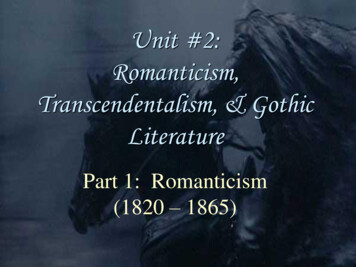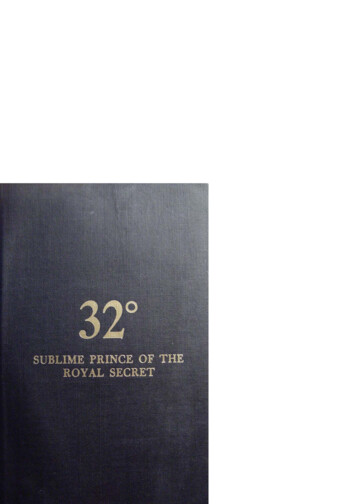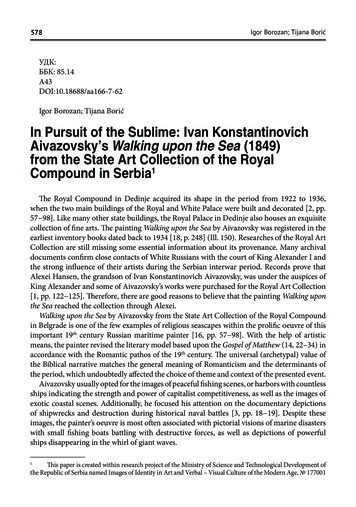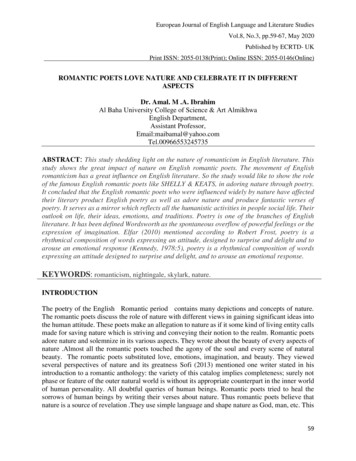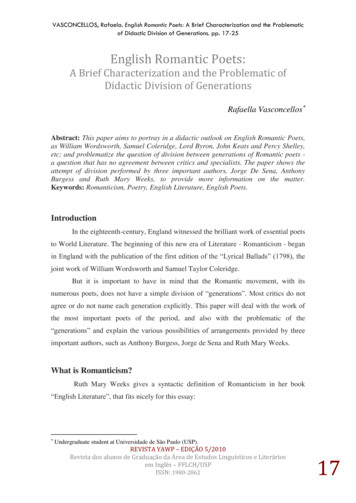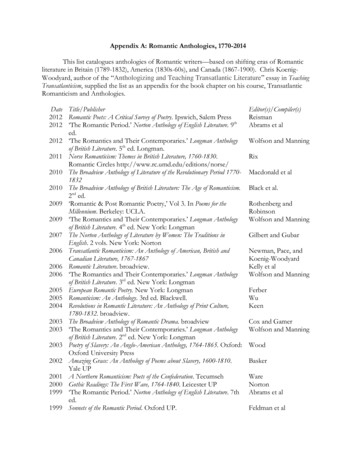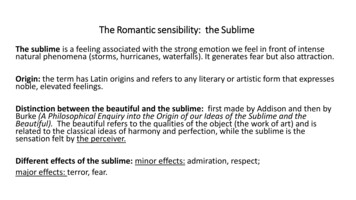
Transcription
The Romantic sensibility: the SublimeThe sublime is a feeling associated with the strong emotion we feel in front of intensenatural phenomena (storms, hurricanes, waterfalls). It generates fear but also attraction.Origin: the term has Latin origins and refers to any literary or artistic form that expressesnoble, elevated feelings.Distinction between the beautiful and the sublime: first made by Addison and then byBurke (A Philosophical Enquiry into the Origin of our Ideas of the Sublime and theBeautiful). The beautiful refers to the qualities of the object (the work of art) and isrelated to the classical ideas of harmony and perfection, while the sublime is thesensation felt by the perceiver.Different effects of the sublime: minor effects: admiration, respect;major effects: terror, fear.
What causes the sublime: fear of pain, vastness of the ocean, obscurity,powerful sources, the infinite, the unfinished, magnificence and colour(sad, dark colours). The sublime is caused either by what is great andimmeasurable or by natural phenomena which underline the frailty ofman. Influence on late 18th century literature: this feeling is central in theworks of Romantic poets and Gothic novelists, and is linked to a passionfor extreme sensations. Influence on painting: painters like Turner and Constable wanted toexpress the sublime in visual art. They were landscape painters and,although in different ways, they emphasized the strength of naturalelements and studied the effects of different weather conditions on thelandscape. For some aspects, they influenced the French impressionists.
Romanticism in English painting Nature and rural life were key-elements of English Romanticism and they were wellrepresented in landscape painting. The rediscovery of simple countryside life was also areaction against industrialization and against the artificial society associated with theFrench Revolution. John Constable and William Turner were the two major landscape painters of the 19thcentury. They both started from the English landscape tradition but their works, thoughvery different, mark an important shift in the tradition of landscape art. They explored the changing weather conditions and their effect on light and movement.Constable was mainly interested in the English countryside, and the sky became apredominant element in his paintings. Turner, on the other hand, very often focused onparticular conditions of the sky and the sea, painting storms and raging seas, thusexpressing the feeling of the sublime. Together they invented and explored a new kind of painting that anticipated FrenchImpressionism.
William TurnerWilliam Turner (1775-1851) was the son of a barber in Covent Garden, London.After little formal education, he was admitted to the Royal Academy Schools at theage of 14, and soon began to exhibit his works.The sea is one of the elemental images of Romanticism. It compelled many artiststo paint it, and even Turner was obsessed by it in all its forms, though most of all byits more violent aspects.
The Shipwreck,1805. Oil on Canvas. Tate Gallery, London
In this painting there is a rough, foamy sea because of the storm and windand some boats are in danger. The lifeboat on the left is pushed by thewaves and the wind, while the ship is going to be overturned.The sky is characterized by moving masses of dark, stormy clouds. The structure of the picture is vortex-like; in this way the seascape isperceived as three-dimensional. Turner rendered the stormy sea by employing minute touches of a finebrush. He emphasized the energy and power of the natural world, which can behighly destructive, and the frailty of man in front of it, thus expressing thefeeling of the sublime. For this reason we can associate him with Coleridge’sRyme of the Ancient Mariner.
Rain, steam and Speed , 1844. National Gallery, London
Turner had an ambivalent attitude towards the Industrial Revolution,but in this painting he made evident his excitement over the machineage.In the painting we can see the locomotive of a train running on arailway bridge. On the left we can see a bridge running across a river,and a little rowing boat on the river.The real protagonists of the painting, however, are light and colour (themain primary colours present are red, yellow and blue). Turner wantedto express the sense of speed, mixed with the elements of nature (rainand clouds).This painting, like many others, is characterized by an «indistinctness»,the land and the sky are not clearly separated. This quality was thecause of hostile reviews at Turner’s times.
John Constable (1776-1837)John Constable was born in 1776 in Suffolk, where his father’s familyowned some properties.In 1796 he went to London and met John Thomas Smith, an engraver,drawing master and antiquarian, who encouraged his interest in art. In1799 he was admitted to the Royal Academy as a student.He was not interested in imaginative subject matter or exotic scenes,but he was inspired by the region of the river Stour, where he hadgrown up.
The Hay Wain, 1821, Oil on canvas, National Gallery, London.
It is a rural scene: on the left margin of the canvas there is a cottage. In the backgroundthere are consistent masses of trees, especially on the left. In the middle we can see themeadows, a horizontal line linking the sky and the water. In the foreground there is astream and the cloudy sky takes up almost half of the painting.Differently from Turner, Constable likes to show the human presence in nature. Here wenotice the man on the cart in the middle, a washer-woman on the left, the hay mowers inthe field and a fisherman in the river. There is also a dog on the left bank who seems toobserve the scene.Constable’s sparking quality of light derives from laying dabs of pure white paint on thesurface. Here they can be identified on the water, on the house and on the leaves of thetrees. Constable also used a varied tone of green.Constable’s landscape is not an objective recreation of what he observed but it containsdeep emotional involvement,and wants to convey this feeling to the perceiver.This painting represents a typical romantic theme: the routine of rural, domestic life. Itpoints out the simplicity of work and the serenity connected with it, it highlights the linkbetween man and nature. For this reason, Constable is often associated with the romanticpoet Wordsworth.
Hadley Castle, 1829. Tate Gallery, LondonConstable’s later years were saddened by the death of his wife. So his works became more«expressionist», he wanted to communicate the emotional reality of the situation and heemphasized the dynamism of the natural world. Thus his landscapes appear more sinisterand turbulent, expressing the feeling of the sublime.
This is Hadleigh, on the Thames estuary.This landscape contains another typical Romantic theme: the ruin.Here the ruin appears to be a continuation of the landscape, in fact inthe heart of the ruin there is a wind-blown tree. The sky is turbulent,grey and cloudy, and there is a human presence: a shepherd with hisdog.The turbulence of the sky, the uniform tone of green, the use ofchiaroscuro express the range of human emotions. In particular, thispicture conveys a sense of desolation and despair, though the use oflight seems to disperse darkness and introuce a gleam of hope.
The beautiful refers to the qualities of the object (the work of art) and is related to the classical ideas of harmony and perfection, while the sublime is the sensation felt by the perceiver. Different effects of the sublime: minor effects: admiration, respect; major effects: terror, fear.

